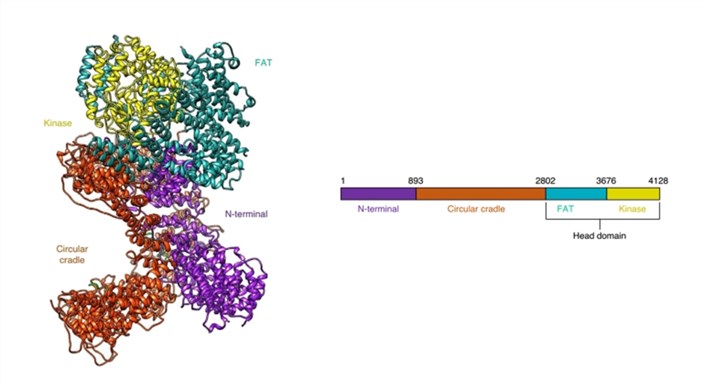What is PRKDC Protein
The PRKDC protein, officially known as Protein Kinase, DNA-Activated, Catalytic Subunit, serves as a linchpin in cellular maintenance and DNA repair processes. Also recognized by its aliases, including DNA-PKcs (DNA-dependent protein kinase, catalytic subunit), XRCC7 (X-ray repair cross-complementing protein 7), and more, this protein belongs to the phosphatidylinositol 3-kinase-related kinase (PIKK) family. Its nomenclature reflects its pivotal role in safeguarding the integrity of genetic material, positioning it at the heart of cellular defense mechanisms.
PRKDC Protein Structural Characteristics and Classification
PRKDC boasts a complex structure characterized by its enormous size, with over 4000 amino acids forming an intricate tapestry. As a member of the PIKK family, it shares structural features with other family members, including ATM (ataxia-telangiectasia mutated) and ATR (ataxia-telangiectasia and Rad3-related). This structural similarity underscores the functional parallelism in their roles as guardians of the genome.
Recent research has delved into the dynamic conformational changes of PRKDC, shedding light on its modular organization and how it orchestrates repair processes. Advanced imaging techniques and structural analyses have unveiled the spatial choreography of PRKDC in action, showcasing its crucial involvement in recognizing and rectifying DNA damage.
PRKDC Biological Functions and Molecular Mechanisms
The biological functions of PRKDC are multifaceted, contributing significantly to the maintenance of genomic stability. PRKDC is the chief architect behind non-homologous end joining (NHEJ), a DNA repair mechanism crucial for addressing double-strand breaks. Acting as a molecular conductor, PRKDC orchestrates the assembly of repair complexes, facilitating the reconnection of broken DNA strands with precision.
Beyond its role in DNA repair, PRKDC plays a pivotal part in cellular responses to various stressors. It acts as a sentinel, activating signaling cascades that halt cell cycle progression when DNA damage is detected. This temporary arrest allows cells to prioritize repair over replication, preventing the propagation of genetic errors.

Figure 1. The overall structure of DNA-PKcs. (Chen Y, et al., 2021)
PRKDC Related Signaling Pathway
The PRKDC signaling pathway is intricately woven into the cellular fabric, responding to cues of DNA damage and orchestrating a cascade of events to rectify disruptions. Central to this pathway is the activation of PRKDC by DNA damage, triggering its kinase activity. Subsequent phosphorylation events initiate the recruitment of repair proteins, culminating in the restoration of genomic integrity.
Understanding the nuances of the PRKDC signaling pathway provides a roadmap for interventions aimed at enhancing DNA repair processes or selectively targeting cancer cells with defective pathways.
PRKDC Related Diseases
Disruptions in PRKDC function have been implicated in various human diseases, highlighting its significance in maintaining cellular homeostasis. Mutations in the PRKDC gene are linked to immunodeficiency disorders, characterized by compromised immune responses due to impaired DNA repair mechanisms. Such conditions underscore the indispensable role of PRKDC in preserving the integrity of immune cells, ensuring their optimal functionality.
Moreover, the association between PRKDC and certain cancers has piqued research interest. Dysregulation of DNA repair processes, attributed to aberrant PRKDC activity, can contribute to genomic instability—a hallmark of cancer. Unraveling these connections holds promise for devising targeted therapeutic strategies.
PRKDC's Applications in Biomedicine
The versatile nature of PRKDC has positioned it as a valuable asset in biomedical research and applications. Its involvement in DNA repair mechanisms makes it a target of interest for diagnostic development, offering insights into the DNA repair proficiency of cells. Evaluating PRKDC levels and activity can serve as a biomarker, aiding in the assessment of cellular resilience to genotoxic stress.
In the realm of vaccine development, PRKDC takes center stage in enhancing our understanding of immune responses. Unraveling its role in immunodeficiency disorders can inform vaccine strategies, particularly in populations with compromised DNA repair capabilities.
Therapeutically, targeting PRKDC presents a compelling avenue for cancer treatment. Exploiting the vulnerabilities of cancer cells with defective DNA repair machinery, drugs designed to modulate PRKDC activity hold promise in selectively sensitizing cancer cells to DNA-damaging agents.
Recommended Products
| Cat.# | Product name | Species | Source (Host) | Tag |
|---|---|---|---|---|
| PRKDC-860H | Recombinant Human PRKDC Protein | Human | HeLa | N/A |
| PRKDC-28357TH | Recombinant Human PRKDC | Human | Wheat Germ | N/A |
| PRKDC-859H | Recombinant Human PRKDC Protein | Human | Insect Cell | N/A |
| PRKDC-3252H | Recombinant Human PRKDC protein, His-tagged | Human | E.coli | His |
| PRKDC-13375M | Recombinant Mouse PRKDC Protein | Mouse | Mammalian Cell | His |
| Prkdc-3370M | Recombinant Mouse Prkdc protein, His-tagged | Mouse | E.coli | His |
| PRKDC-7100M | Recombinant Mouse PRKDC Protein, His (Fc)-Avi-tagged | Mouse | HEK293 | His (Fc)-Avi |
| Prkdc-1774M | Recombinant Mouse Prkdc protein, His & T7-tagged | Mouse | E.coli | His/T7 |
| PRKDC-6226C | Recombinant Chicken PRKDC | Mammalian Cell | His |
Reference
- Chen Y, et al. Role of PRKDC in cancer initiation, progression, and treatment. Cancer Cell International. 2021, 21(1): 1-10.

